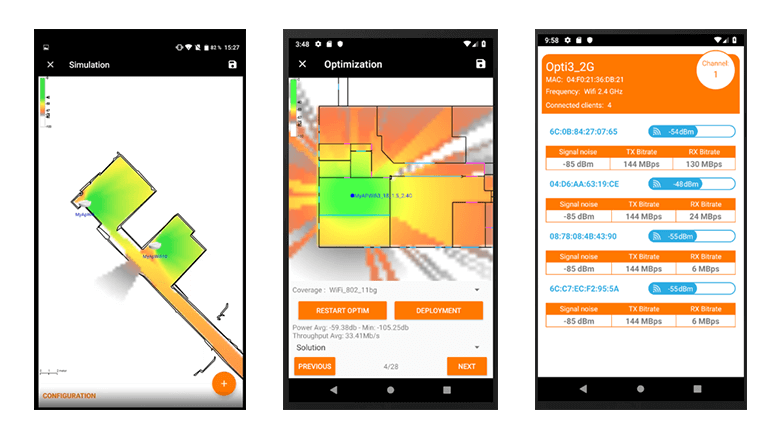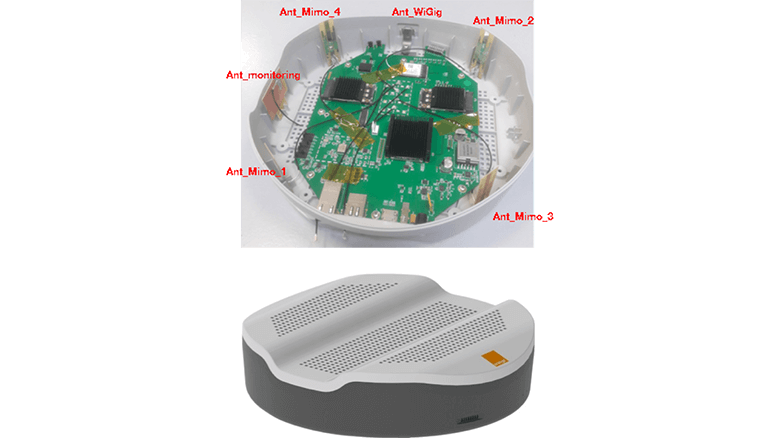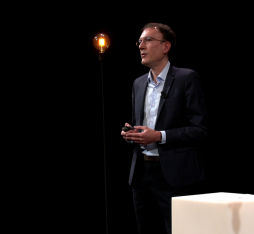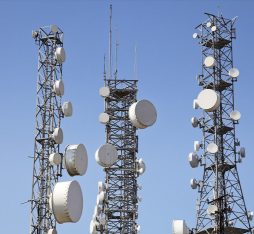Summary
As Wi-Fi is evolving and smart building services are emerging, more and more radio standards are being deployed in the networks of small businesses. These standards support a wide range of services, from TV to web, phone (VoIP) and home automation. However, most end users do not have any expertise in radio networks. With academic partners (INSA de Rennes and Institut Mines Télécom) and three companies (MVG Industries, Tact Factory and eSoftThings), Orange has developed the OptimiSME solution to meet this type of expectations. Through a dedicated app, this service makes it possible to assess their needs, while optimising and supervising the network’s deployment. OptimiSME offers Wi-Fi access points with speeds of over 1 gigabyte for premises from 200 to 500 m² for simultaneous use on a few dozen desktops and laptops, with the possibility to connect motion sensors, smoke detectors and door-window sensors. Usage can also be analysed to share recommendations with users to reposition or add Wi-Fi access points. A next step could be to offer the deployment app to help SMEs to position their Wi-Fi access points by themselves to achieve the good coverage required for their premises.
Full Article
As Wi-Fi is evolving and smart building services are emerging, more and more radio standards are being deployed in the networks of small businesses (as well as in the homes of consumers). These radio standards support a wide range of TV, web, phone (VoIP) and home automation services, from security to comfort, energy and fitness. Most end users do not have any expertise in radio networks. To enable them to simply and easily deploy their networks for all these services, it is important to offer them new equipment and tools that are aligned with their needs.
To achieve these goals, Orange mapped out and led a French cooperative project, known as OptimiSME, over 39 months between November 2016 and April 2019. This project, recognised by the competitiveness cluster “Im@ges et Réseaux” and funded by the French State through the BPI, as well as by the Brittany Region, Rennes Métropole and Brest Métropole Océane, brought together three companies – MVG Industries, Tact Factory and eSoftThings – and two academic representatives – INSA de Rennes and Institut Mines Télécom – around Orange.

Figure 1. FUI OptimiSME project funders

Figure 2. FUI OptimiSME project partners
Project to meet the needs of SMEs
End user: a head of a business with a few dozen people without any network knowledge and therefore no staff who are experts in this area.
Needs: wireless network coverage for premises from 200 to 500 m², split between 2-3 meeting rooms, offices and communal areas (corridors, etc.), to enable simultaneous uses and benefit from the speed offered by the SME’s fibre connection. They would like to connect a few dozen desktops and laptops, as well as motion sensors, smoke detectors and door-window sensors.
Scenario: the user looking to acquire the OptimiSME solution contacts their operator, which invites them to download the OptimiSME network deployment optimisation app in order to assess their needs.
In this app, they enter the layout of their premises, indicate their needs for services and any other constraints (position of the box, location of network sockets, etc.). The operator can help them enter this information.
The mobile app advises them to acquire a particular number of Wi-Fi access points and indicates their locations to cover all the premises with a speed of 1 gigabyte per second.
Once the network has been deployed, the quality of all the links is monitored and the use of radio resources is optimised. The network load is automatically distributed between the various frequency bands and the various access points in order to provide the best speed across all devices. Usage can also be analysed to share recommendations with the user to reposition or add Wi-Fi access points.
Mobile apps to help users
The main objective has been to develop software tools that are partially embedded in elements from the local network infrastructure. These tools aim to optimise the positioning of these infrastructure elements during the network’s initial deployment, and to manage and optimise this network’s radio resources based on supervising the network and learning how it is used.

Figure 3. Mobile app supporting the network’s deployment and supervision
With the arrival of fibre, customers’ expectations are becoming increasingly demanding for the deployment of high-speed radio connectivity in all their company buildings (or their entire home for consumers) in order to benefit from the performance levels promised by fibre in each and every room. Two main constraints have been taken into account for optimising the local network defined for OptimiSME:
- Coverage: the notion of speed becomes less important with home automation services, whose sensors send messages of just a few bytes, generally with a frequency of less than a minute. However, the notion of coverage and guaranteed service is crucial when these services relate to security: detecting intruders, smoke, etc.
- Network infrastructure cost: minimal number of pieces of equipment to be deployed (the elements support all radio standards) and individual cost of equipment providing both radio access for the Wi-Fi devices, as well as the sensors and other home automation equipment.
The mobile app uses the WANDA radio propagation simulation software developed by Orange Labs at the Belfort site.
A second objective with the OptimiSME project was to prepare specifications and mock-ups for the network infrastructure elements supporting several radio standards. To reduce deployment costs, the radio access points supporting high-speed and low-speed services have been pooled on convergent equipment.

Figure 4. Internal and external view of the radio access point (Wi-Fi, Bluetooth) developed for OptimiSME
Challenge of Wi-Fi at 60 GHz
Among the radio standards considered, the OptimiSME project focused in particular on Wi-Fi in the 60 GHz frequency band, known as WiGig, making it possible to achieve speeds of over 1Gb, but introducing specific deployment constraints due to the radio signal’s limited range. This radio option was chosen because it supplements the standard 2.4 GHz and 5 GHz Wi-Fi bands to provide increased speed. In the 60 GHz band, interferences are significantly reduced compared with bands under 6 GHz, because it is used by few access points today and the 60 GHz Wi-Fi signal is very affected by walls.
In addition, due to different propagation constraints depending on the frequencies used (from 800 MHz to 60 GHz), optimising the deployment becomes more complex. One box is not always enough to guarantee the coverage required by users for their premises, especially in difficult environments that involve metal partition walls for instance.
The supervision of these diverse radio networks (Wi-Fi, Bluetooth, etc.) also becomes more complex. It has become important to identify reliable, robust and harmonised quality metrics for radio links so that all the radio resources can be managed as one unit.
The OptimiSME research project’s findings and the solutions implemented have enabled Orange to better understand the technical issues involved with the deployment of wireless networks in buildings. The next step could be to offer the deployment app to help SME customers to position their Wi-Fi access points by themselves to achieve the good coverage required for their premises. This app could be provided with the Wi-Fi extenders identified for the project and sold as part of a package.
Learn more:

Orange Labs led the OptimiSME project, defined the project’s use cases, carried out radio channel measurements with the different Wi-Fi frequency bands used and developed algorithms making it possible to optimise the Wi-Fi radio resources.

For this project, MVG Industries specified and developed five prototypes for tri-band Wi-Fi access points: 2.4 GHz, 5 GHz and 60 GHz. Bluetooth is also integrated into these access points.

eSoftThings developed a mechanism for collecting radio indicators (power, error rate, etc.) for the Wi-Fi access points developed with the project and made them available on a centralised server.

Tact Factory developed the mobile app supporting the Wi-Fi network’s deployment and supervision.

INSA-IETR carried out 60 GHz channel measurements, liaising with Orange to characterise the indoor environment for the project.

Institut Mines Telecom, through the contribution of IMT Atlantique, carried out the radio characterisation of Wi-Fi access points and, through the contribution of Telecom Paris, developed algorithms to optimise the positioning of Wi-Fi access points within a building.
Learn more:
The internal view of the radio extender unit presented in Figure 4 also shows the positioning of the Wi-Fi antennas: four antennas for sending/receiving data in the 2.4 GHz / 5 GHz bands (Ant_Mimo_X), one antenna for monitoring the channel in the 2.4 GHz/5 GHz bands (Ant_Monitoring) and one antenna for transmitting/receiving in the 60 GHz band (Ant_WiGig).










